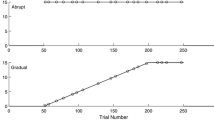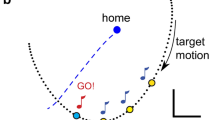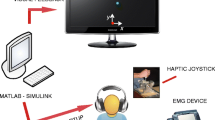Abstract
The viscoelastic properties of the human arm were measured by means of short force perturbations during fast reaching movements in two orthogonal directions. A linear spring model with time delay described the neuromuscular system of the human arm. The obtained viscoelastic parameters ensured movement stability in spite of the time delay of 50 ms. The stiffness and viscosity ellipses appeared to be predominantly orthogonal to the movement direction, which reduced the effect of force perturbation in the direction orthogonal to the reaching movement. Thus, it can be argued that the viscoelastic properties of the neuromuscular system of the human arm are adjusted to the direction of movement according to a “path preserving” strategy, which minimizes the deviation of the movement path from a straight line, when exposed to an unexpected external force.
Similar content being viewed by others
References
Bennett DJ (1994) Stretch responses in the human elbow joint during a voluntary movement. J Physiol (Lond) 474:339–351
Bennett DJ, Hollerbach JM, Xu Y, Hunter IW (1992) Time varying stiffness of human elbow joint during cyclic voluntary movement. Exp Brain Res 88:433–422
Biryukova EV, Roschin VY, Frolov AA, Ioffe ME, Massion J, Dufosse M (1999) Forearm postural control during unloading: anticipatory changes in elbow stiffness Exp Brain Res 124:107–117
Biryukova EV, Roby-Brami A, Frolov AA, Mokhtari M (2000) Kinematics of human arm reconstructed from spatial tracking system recordings. J Biomech 33:985–995
Burdet E, Osu R, Franklin DW, Milner TE, Kawato M (2001) The central nervous system stabilizes unstable dynamics by learning optimal impedance. Nature 414:446–449
Cesari P, Shiratori T, Olivato P, Duarte M (2001) Analysis of kinematically redundant reaching movements using the equilibrium-point hypothesis. Biol Cybern 84:217–226
Domen K, Latash ML, Zatsiorsky VM (1999) Reconstruction of equilibrium trajectories during whole-body movements. Biol Cybern 80:195–204
Feldman AG (1979) Central and reflex mechanisms of motor control (in Russian). Nauka, Moscow
Feldman AG, Levin MF (1995) The origin and use of positional frames of reference in motor control. Behav Brain Sci 18:723–806
Flanagan AG, Ostry DJ, Feldman AG (1993) Control of trajectory modification in target-directed reaching. J Mot Behav 25:140–152
Flash T (1987) The control of hand equilibrium trajectories in multi-joint arm movements. Biol Cybern 57:257–274
Flash T, Mussa-Ivaldi FA (1990) Human arm stiffness characteristics during the maintenance of posture. Exp Brain Res 82: 315–326
Franklin DW, Burdet E, Osu R, Kawato M, Milner TE (2003) Functional significance of stiffness in adaptation of multijoint arm movements to stable and unstable dynamics. Exp Brain Res 151(2):145–157
Frolov AA, Dufossé M, Řízek S, Kaladjian A (2000) On the possibility of linear modelling the human arm neuromuscular apparatus. Biol Cybern 82:499–515
Gomi H, Kawato M (1997) Human arm stiffness and equilibrium-point trajectory during multi-joint movement. Biol Cybern 76(3):163–171
Gomi H, Osu R (1998) Task-dependent viscoelasticity of human multijoint arm and its spatial characteristics for interaction with environments. J Neurosci 18(21):8965–8978
Gordon J, Ghilardi MF, Ghez C (1994) Accuracy of planar reaching movements. I. Independence of direction and extent variability. Exp Brain Res 99(1):97–111
Gribble PL, Ostry DJ, Sanguineti V, Laboissiére R (1998) Are complex control signals required for human arm movement? J Neurophysiol 79:1409–1424
Hasan Z (1983) A model of spindle afferent response to muscle stretch. J Neurophysiol 49(4):989–1006
Hogan N (1985) The mechanics of multi-joint posture and movement control. Biol Cybern 52:315–331
Katayama M, Kawato M (1993) Virtual trajectory and stiffness ellipse during multi-joint arm movement predicted by neural inverse models. Biol Cybern 69:353–362
Kawato M, Furukawa K, Suzuki R (1987) A hierarchical neural-network model for control and learning of voluntary movement. Biol Cybern 57:169–185
Koshland GF, Hasan Z (2000) Electromyographic responses to a mechanical perturbation applied during impending arm movements in different directions: one-joint and two-joint conditions. Exp Brain Res 132(4):485–499
Lacquaniti F, Carrozo M, Borghese NA (1993) Time-varying mechanical behavior of multijointed arm in man. J Neurophysiol 69:1443–1463
Mah CD (2001) Spatial and temporal modulation of joint stiffness during multijoint movement. Exp Brain Res 136:492–506
Mussa-Ivaldi FA, Hogan N, Bizzi E (1985) Neural, mechanical, and geometric factors subserving arm posture in humans. J Neurosci 5:2732–2743
Perreault EJ, Kirsch RF, Crago PE (2002) Voluntary control of static endpoint stiffness. J Neurophysiol 87:2808–2816
Prokopenko RA, Frolov AA, Biryukova EV, Roby-Brami A (2001) Assessment of the accuracy of a human arm model with seven degrees of freedom. J Biomech 34:177–185
Shadmehr R (1993) Control of equilibrium position and stiffness through postural modules. J Mot Behav 25:228–241
Shadmehr R, Arbib MA (1992) A mathematical analysis of the force-stiffness characteristics of muscles in control of a single joint system. Biol Cybern 66:463–477
Stein RB, Kearney RE (1995) Nonlinear behavior of muscle reflexes at the human ankle joint. J Neurophysiol 73: 65–72
Todorov E, Jordan MI (2002) Optimal feedback control as a theory of motor coordination. Nat Neurosci. 5(11):1226–1235
Tsuji T, Morasso P, Goto K, Ito K (1995) Human hand impedance characteristics during maintained posture in multi-joint arm movements. Biol Cybern 72:475–485
Winters JM, Stark L (1987) Muscle models: what is gained and what is lost by varying model complexity. Biol Cybern 55:403–420
Author information
Authors and Affiliations
Corresponding author
Rights and permissions
About this article
Cite this article
Frolov, A.A., Prokopenko, R.A., Dufossè, M. et al. Adjustment of the human arm viscoelastic properties to the direction of reaching. Biol Cybern 94, 97–109 (2006). https://doi.org/10.1007/s00422-005-0018-8
Received:
Accepted:
Published:
Issue Date:
DOI: https://doi.org/10.1007/s00422-005-0018-8




